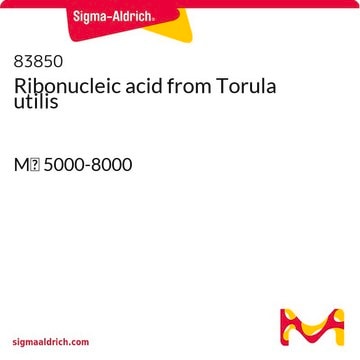This product is a heterogeneous mixture of tRNA molecules This material has not been sequenced.
R6625
Ribonucleic acid from torula yeast
Type VI
Synonym(s):
RNA
Select a Size
Select a Size
About This Item
Recommended Products
Looking for similar products? Visit Product Comparison Guide
General description
Application
Ribonucleic acid (RNA) from torula yeast may be used as a substrate for studying ribonuclease activities of enzymes such as ribonuclease-A, ribonuclease T1 (RNAase), and bougainvillea xbuttiana antiviral protein 1 (BBAP1)
Quality
Storage Class Code
11 - Combustible Solids
WGK
WGK 3
Flash Point(F)
Not applicable
Flash Point(C)
Not applicable
Personal Protective Equipment
Choose from one of the most recent versions:
Certificates of Analysis (COA)
Don't see the Right Version?
If you require a particular version, you can look up a specific certificate by the Lot or Batch number.
Already Own This Product?
Find documentation for the products that you have recently purchased in the Document Library.
Customers Also Viewed
-
What are the nucleotide sequences of the mixture of RNA?
1 answer-
Helpful?
-
-
How many base pairs are in the RNA? Can I dossolve it in TE buffer?
1 answer-
This product is a heterogeneous mixture of RNA molecules ranging from 3000 to 40000 daltons which corresponds to approximately 10 to 120 base pairs in size. The material is tested for solubility at 10 mg per 1 ml of 0.1M Acetate buffer, pH 5.0. Testing is TE buffer is not performed. However, this buffer is commonly used as short term storage buffer for RNA.
Please see the link below to review the oligo handling and stability guide for additional information: https://www.sigmaaldrich.com/US/en/technical-documents/protocol/genomics/dna-and-rna-purification/oligonucleotide-handling-and-stability
Helpful?
-
-
I would like to know if this product RNA from torula yeast (R6625) contains only mRNA and rRNA or does it also contains transfer-RNA?
1 answer-
This product is not assayed for the distribution of RNA forms, but it is expected to be a heterogeneous mixture ranging from 3000 to 40000 Daltons.
Helpful?
-
-
What does type VI mean?
1 answer-
The 'type' designation for this product is an internal definition of Sigma and has no specific biological significance. It is in reference to the method of manufacture or product preparation.
Helpful?
-
-
What does Type IV refer to?
1 answer-
The 'type' designation for this product is an internal definition of Sigma and has no specific biological significance. It is in reference to the method of manufacture or product preparation.
Helpful?
-
-
What is the molecular weight of this product? What is the RNA concentration?
1 answer-
This product is a heterogeneous mixture of RNA molecules ranging from 3000 to 40000 in MW. The material is not tested for purity. There is a maximum allowable water content specification of 10%. Please see the link below for review a sample Certificate of Analysis:
https://www.sigmaaldrich.com/certificates/sapfs/PROD/sap/certificate_pdfs/COFA/Q14/R6625-BULKWXBF1071V.pdfHelpful?
-
-
What species is Product R6625, Ribonucleic acid from torula yeast, from?
1 answer-
The former taxonomic name for Torula yeast is Torulopsis utilus; the current name is Candida utilus.
Helpful?
-
-
What is the Department of Transportation shipping information for this product?
1 answer-
Transportation information can be found in Section 14 of the product's (M)SDS.To access the shipping information for this material, use the link on the product detail page for the product.
Helpful?
-
Active Filters
Our team of scientists has experience in all areas of research including Life Science, Material Science, Chemical Synthesis, Chromatography, Analytical and many others.
Contact Technical Service








